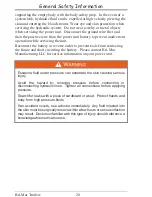
General Safety Information
Bri-Mar
24
Stop the rig a few times from speeds no greater than 10 mph. If your
trailer is equipped with brakes, try using different combinations of
trailer/electric brake and tow vehicle brake. Note the effect that the
trailer brakes have when they are the only brakes used. When properly
adjusted, the trailer brakes will come on just before the tow vehicle
brakes.
It will take practice to learn how to back up a tow vehicle with a trailer
attached. Take it slow. Before backing up, get out of the tow vehicle
and look behind the trailer to make sure that there are no obstacles. Some
drivers place their hands at the bottom of the steering wheel, and while
the tow vehicle is in reverse, “think” of the hands as being on the top of
the wheel. When the hands move to the right (counter-clockwise, as you
would do to turn the tow vehicle to the left when moving forward), the
rear of the trailer moves to the right. Conversely, rotating the steering
wheel clockwise with your hands at the bottom of the wheel will move
the rear of the trailer to the left, while backing up. If you are towing a
bumper hitch rig, be careful not to allow the trailer to turn too much,
because it will hit the rear of the tow vehicle. To straighten the rig,
either pull forward, or turn the steering wheel in the opposite direction.
2.2.19 Safe Trailer Towing Guidelines
•
Recheck the load tiedowns to make sure the load will not shift during
towing.
•
Before towing, check coupling, safety chains, safety brake, tires,
wheels and lights.
•
Check the lug nuts or bolts for tightness.
•
Check coupler tightness after towing 50 miles.
•
Adjust the brake controller to engage the trailer brakes before the
tow vehicle brakes. Follow the instructions given with the brake
controller manufacturer’s literature.
•
Use your mirrors to verify that you have room to change lanes or
pull into traffic.
•
Use your turn signals well in advance.
•
Allow plenty of stopping space for your trailer and tow vehicle.
•
Do not drive so fast that the trailer begins to sway due to speed.
Generally never drive faster than 60 m.p.h.
Trailers
Summary of Contents for DT508LP
Page 144: ...Electrical Drawings Bri Mar 138 Trailers...
Page 145: ...Bri Mar 139 9 ELECTRICAL DRAWINGS Trailers...
Page 146: ...Bri Mar 140 Trailers...
















































